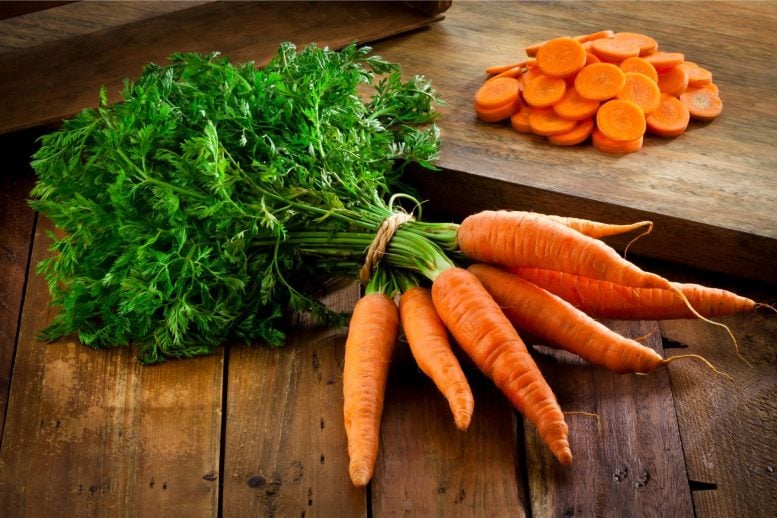 精选
精选
胡萝卜与糖尿病:令人惊讶的新研究动摇了治疗方案
诸平
2015年,全球有4.15亿成年2型糖尿病(T2D)患者,预计到2040年这一数字将增加4200万。但是,据丹麦南丹麦大学健康科学学院(University of Southern Denmark简称SDU, Faculty of Health Sciences)2025年1月13日提供的消息,胡萝卜与糖尿病:令人惊讶的新研究动摇了治疗方案(Carrots vs. Diabetes: Surprising New Research Shakes Up Treatment Options)。
SDU的一项新研究表明,胡萝卜可以改善血糖调节,促进更健康的肠道微生物群,可能为2型糖尿病治疗提供天然补充。研究人员发现,与不吃胡萝卜的老鼠相比,吃胡萝卜粉的老鼠有更好的血糖控制和更多有益的肠道细菌。
南丹麦大学(SDU, Odense M, Denmark)最近的研究表明,胡萝卜可能有助于调节血糖水平,增强肠道健康,为2型糖尿病患者提供潜在的益处。{Recent research from the University of Southern Denmark (SDU) suggests that carrots may help regulate blood sugar levels and enhance gut health, offering potential benefits for individuals with type 2 diabetes.}
SDU最近的一项研究表明,普通胡萝卜可能有助于改善2型糖尿病的治疗。研究人员发现,胡萝卜可以提高人体调节血糖水平的能力,并对肠道细菌组成产生积极影响。
2型糖尿病影响着全世界数百万人,全球和丹麦的病例都在稳步增加。自1996年以来,仅丹麦确诊病例的数量就增加了四倍多。
2型糖尿病的标准治疗通常包括饮食改变和药物治疗,但许多患者会经历普通药物的副作用。来自SDU、欧登塞大学医院(Odense University Hospital, Odense C, Denmark)和哥本哈根大学(University of Copenhagen, Frederiksberg C, Denmark)的研究人员合作完成了这项新发表的研究,他们认为胡萝卜可以为现有的治疗提供一种天然的、无副作用的补充。原文详见:Morten Kobaek-Larsen, Sina Maschek, Stefanie Hansborg Kolstrup, Kurt Højlund, Dennis Sandris Nielsen, Axel Kornerup Hansen, Lars Porskjær Christensen. Effect of carrot intake on glucose tolerance, microbiota, and gene expression in a type 2 diabetes mouse model. Clinical and Translational Science, 2024, 17(12): e70090. DOI: 10.1111/cts.70090. Published 3 December 2024. https://doi.org/10.1111/cts.70090
胡萝卜对血糖和肠道细菌的影响(The impact of carrots on blood sugar and gut bacteria)
研究人员在16周的时间里,用患有2型糖尿病的老鼠研究了胡萝卜的效果。为了模仿不健康的人类生活方式,这些老鼠被喂食高脂肪食物。它们被分成两组:一组饮食中添加10%的冻干胡萝卜粉(carrot powder),而另一组饮食中没有胡萝卜粉。两种饮食都是卡路里匹配的,确保唯一的变量是胡萝卜中的生物活性化合物。结果显示,通过葡萄糖耐量测试(glucose tolerance tests),摄入胡萝卜粉的那组表现出改善的血糖调节能力。
葡萄糖耐量测试测量人体在摄入一定量的糖后调节血糖的能力。在这项研究中,研究人员给老鼠喂了一种糖溶液,并在一段时间内测量它们的血糖水平。
SDU临床研究系(Department of Clinical Research, SDU)副教授、项目协调员Morten Kobæk Larsen解释说:“我们的研究表明,胡萝卜改变了肠道微生物群的组成,肠道中生活的数十亿微生物,在消化和健康中起着至关重要的作用。食用胡萝卜的老鼠肠道细菌表现出更健康的平衡。”
此外,这些小鼠有更多的细菌产生短链脂肪酸(short-chain fatty acids简称SCFAs)。细菌分解膳食纤维时形成的这些小分子有助于调节能量代谢和血糖,同时支持肠道健康。
Morten Kobæk Larsen解释说:“我们吃的任何东西都会影响肠道细菌的组成。食用胡萝卜可以使肠道细菌达到更健康的平衡,对患有2型糖尿病的老鼠有益。”
胡萝卜是如何起作用的?(How do carrots work?)
胡萝卜含有生物活性化合物,可以增强细胞吸收糖分的能力,从而帮助调节血糖。这些来自不饱和脂肪酸的生物活性物质也存在于胡萝卜科(carrot family)的其它蔬菜中,如欧芹(parsley)、芹菜(celery)和欧洲防风草(也叫欧洲萝卜,parsnips)。
SDU物理、化学和药学系(Department of Physics, Chemistry, and Pharmacy, SDU)分析化学和天然产物化学教授Lars Porskjær Christensen说:“我们认为胡萝卜是未来2型糖尿病饮食策略的潜在组成部分。胡萝卜科的其他蔬菜可能也有类似的特性。”
胡萝卜能帮助人类吗?(Could carrots help humans?)
研究人员对将他们的发现直接应用于人类持谨慎态度。
Lars Porskjær Christensen说:“我们的研究使用了动物模型,下一步需要进行临床试验,他们解释说。临床试验的研究是昂贵的,我们正在努力争取外部资金,用含有相对大量生物活性化合物的胡萝卜进行一个较小的临床试验。这可能为更大规模的临床研究铺平道路,包括用纯化的生物活性化合物在动物身上进行的研究,从而证实胡萝卜对2型糖尿病的预防作用。”
一项关于胡萝卜对结肠癌的影响的类似研究的初步结果表明,每天只吃30~40 g生胡萝卜或煮熟的胡萝卜(raw or lightly cooked carrots)就会有有益的效果。
根据研究人员的说法,不同品种的胡萝卜中生物活性化合物的浓度差异很大。然而,正确的品种可以提供足够剂量的这些化合物,而不需要浓缩产品。例如,“夜鸟”品种(‘Night Bird’ variety)即一种紫色胡萝卜(purple carrot),含有相对高浓度的生物活性物质。
制备工作重要吗?(Does preparation matter?)
烹饪会影响促进健康物质的含量,但它们不会完全消失。
“即使经过长时间的油炸或煮沸,一些生物活性化合物仍然存在。然而,生的或稍微煮熟的胡萝卜似乎是保留尽可能多的有益化合物的最佳选择,”Lars Porskjær Christensen建议。
生物活性化合物是什么?(What are bioactive compounds?)
生物活性化合物是影响生理过程的生物来源的有机化学物质。许多是从植物和真菌中提取的,对人体有有益或有害的影响。来自植物和真菌的一些生物活性化合物被用于药物,而其他植物性食品被认为可以促进健康和预防疾病。它们的作用取决于作用机制、生物利用度和食物中的浓度,这可能因作物品种、栽培和加工而异。
关于胡萝卜的事实(Facts about carrots)
胡萝卜中的主要生物活性化合物是镰叶芹醇(falcarinol)和镰叶芹二醇(falcarindiol),这种蔬菜产生的镰叶芹醇是为了抵御真菌感染。除了抗真菌(antifungal)外,这些化合物还具有抗菌(antibacterial)、抗炎(anti-inflammatory)和细胞毒性作用(cytotoxic effects)。
本研究得到了欧登塞大学医院免费研究基金{Odense University Hospital Fund for Free Research (122‐A5125)}的支持。
上述介绍,仅供参考。欲了解更多信息,敬请注意浏览原文或者相关报道。
Type 2 diabetes (T2D) pathophysiology involves insulin resistance (IR) and inadequate insulin secretion. Current T2D management includes dietary adjustments and/or oral medications such as thiazolidinediones (TZDs). Carrots have shown to contain bioactive acetylenic oxylipins that are partial agonists of the peroxisome proliferator‐activated receptor γ (Pparg) that mimic the antidiabetic effect of TZDs without any adverse effects. TZDs exert hypoglycemic effects through activation of Pparg and through the regulation of the gut microbiota (GM) producing short‐chain fatty acids (SCFAs), which impact glucose and energy homeostasis, promote intestinal gluconeogenesis, and influence insulin signaling pathways. This study investigated the metabolic effects of carrot intake in a T2D mouse model, elucidating underlying mechanisms. Mice were fed a low‐fat diet (LFD), high‐fat diet (HFD), or adjusted HFD supplemented with 10% carrot powder for 16 weeks. Oral glucose tolerance tests were conducted at weeks 0 and 16. Fecal, cecum, and colon samples, as well as tissue samples, were collected at week 16 during the autopsy. Results showed improved oral glucose tolerance in the HFD carrot group compared to HFD alone after 16 weeks. GM analysis demonstrated increased diversity and compositional changes in the cecum of mice fed HFD with carrot relative to HFD. These findings suggest the potential effect of carrots in T2D management, possibly through modulation of GM. Gene expression analysis revealed no significant alterations in adipose or muscle tissue between diet groups. Further research into carrot‐derived bioactive compounds and their mechanisms of action is warranted for developing effective dietary strategies against T2D.
What is the current knowledge on the topic?
T2D involves IR and inadequate insulin secretion. Management typically includes dietary adjustments and medications like TZDs. Carrots contain bioactive polyacetylenes that act as partial agonists of Pparg, mimicking TZDs' antidiabetic effects without adverse outcomes.
What question did this study address?
The study investigated the metabolic effects of carrot intake in a T2D mouse model and aimed to elucidate the underlying mechanisms involved.
What does this study add to our knowledge?
The study found that a HFD supplemented with 10% carrot powder improved oral glucose tolerance and increased GM diversity and composition in T2D mice. These effects suggest the potential of carrots in managing T2D through GM modulation. Gene expression analysis showed no significant changes in adipose or muscle tissues between diet groups.
How might this change clinical pharmacology or translational science?
The findings of this study highlight the potential of carrots as a complementary strategy for T2D management, leveraging GM modulation without side effects. This opens avenues for further research into the bioactive compounds of carrots with potential antidiabetic effects leading to new dietary interventions and advancements in the prevention and treatment of T2D.
转载本文请联系原作者获取授权,同时请注明本文来自诸平科学网博客。
链接地址:https://wap.sciencenet.cn/blog-212210-1468827.html?mobile=1
收藏


